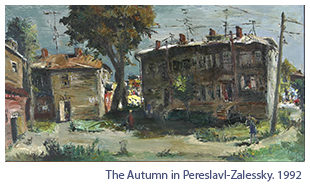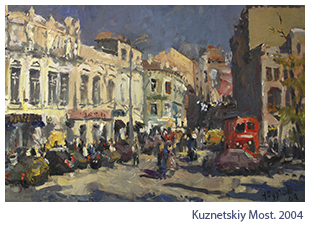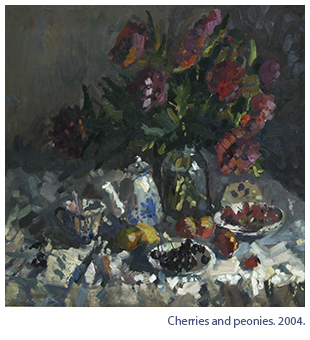NIKOLAY BURTOV: «PAINTING IS MY LIFE»
No one could ever explain why a person would once decide to become an artist and why all through the life he would believe there could be no other way for him. This is what happened to Nikolay Burtov, a Distinguished Artist of the Russian Federation.

Born in 1956 in a family were painting was never referred to, Nikolay Burtov would have never known what his destiny would be like if not for a chance: their neighbor Uncle Kostya, a designer, has presented to the boy a book of fairy tales illustrated by Apollinary Vasnetsov. Little Kolya watched the pictures as a miracle, as a window to another world. Perhaps, since that moment paints and paintbrushes have become his loyal friends. Bringing small Nikolay on a visit to the grandmother, in a village near Yelets, his parents left him the colours. For a city boy the country life was filled with everyday discoveries. The sophisticated Yelets lacework along with carving-decorated window shutters, and fairy tales told for the night at the wicker lamp light ? these altogether have affected Nikolay’s perception of Russian culture.
It’s symbolic that Nikolay started making his first sketches after he met a religious procession in the village. There after came lessons in a fine arts studio at school, in a children's studio at the culture house in the town of Podolsk, where the boy had acquired his first art skills.
There were a few people who significantly influenced Nikolay's creativity. The first one to mention was Victor Lashin who had been bringing up many talented kids at his fine arts studio for a long time. Victor Lashin was a teacher idolized by many, he had led many young talents by a road to the world of fine arts. A little later, in the end of 1970s, Nikolay entered the Fine Arts  School to commemorate the revolutionary year of 1905. When a student, Burtov attends a workshop of an outstanding teacher Yury Sedov, who greatly added to the young student’s personality both the skills in artistic trade and the understanding of arts, sharing generously his worldly wisdom. Burtov says, «Sedov helped wake up a true personality of the artist, comprehend the fine art philosophy, define the civic-mindedness». At School Y.G. Sedov, a real Master, taught his students «to form up an objective before plunging to performance». Yury Sedov used to bring his students to a vault in the Pushkin Fine Arts Museum, where he showed them albums with drawings and graphics introduced his students to the world of Hans Holbein, Pierre Bonnard, Peter Paul Rubens, Ferdinand Hodler and Rembrandt van Rijn, who made a sort of reference point in painting for Nikolay Burtov.
School to commemorate the revolutionary year of 1905. When a student, Burtov attends a workshop of an outstanding teacher Yury Sedov, who greatly added to the young student’s personality both the skills in artistic trade and the understanding of arts, sharing generously his worldly wisdom. Burtov says, «Sedov helped wake up a true personality of the artist, comprehend the fine art philosophy, define the civic-mindedness». At School Y.G. Sedov, a real Master, taught his students «to form up an objective before plunging to performance». Yury Sedov used to bring his students to a vault in the Pushkin Fine Arts Museum, where he showed them albums with drawings and graphics introduced his students to the world of Hans Holbein, Pierre Bonnard, Peter Paul Rubens, Ferdinand Hodler and Rembrandt van Rijn, who made a sort of reference point in painting for Nikolay Burtov.
Realizing that it was a continuity of traditions along with serious knowledge of the world history of arts, self-education and a permanent work that would make a master of a painter, Burtov has been studying all art processes occurring both in Russia and Europe. Since the second half of 1980s Burtov has taken a successful part in a creative life of Russia: he joined a youth association of the USSR Union of Artists, later ? the Union of Artists of Russia. Open-airs, creative trips, the first exhibitions, études in different genres and technicians - all that was needed to choose his own way in art.
The early period of Nikolay Burtov’s creative work has fallen onto the late 1980s - early 1990s. It happened to be a critical time when the era of socialist realism was left behind, when «it was just hard to remain in art». The perception of many traditional spheres of work, including art, was changing dramatically. However, at this hard time Nikolay Burtov believed that an artist was primarily «a person completely devoted to his work». His internal belief in the genuineness of the choice he’s made, his comprehension that solely an internal freedom could help him survive and become a real master, all that have helped Burtov remain in art.
They say, crucial moments in the life of the nation most always acquire a concrete reflection in art. It was no mere chance at that time Nikolay had created the works of social dimension: triptychs «Our Brass Band», "The Wedding", the works «On Shift» and "Holidays". Some of them have been displayed at the All-Union Youth Exhibition in the Manezh, reported by the TV news program "Vremya" and purchased by the Ministry of Culture and the Exhibitions Directorate. An intense dark color scale, a very dense painting filled up with internal dramatic nature - thus in his early works Nikolay Burtov expressed his sharp perception of the reality by means of colours. At that time his paintings revealed no sensation of freedom of space - it seems that every experience and secret thoughts of the artist on vital collisions had been concentrated on the canvas.
Gradually, Burtov understood that his true vocation was landscape painting. And though the genre and landscape closely intertwined in his canvas, the genre elements only supplemented the general panorama. «Ferapontovo» (1988), «The Belorusskaya Railway Station Square» (1989), «Autumn in Pereslavl’-Zalessky» (1992), «A Rainy Day in Moscow» (1993)  clearly demonstrated how Russia has become a major theme in Nikolay Burtov's works. Even his numerous trips around the world (Italy, Cuba, France, China, Austria, India, etc.) helped strengthening a feeling of national consciousness and understanding of national history.
clearly demonstrated how Russia has become a major theme in Nikolay Burtov's works. Even his numerous trips around the world (Italy, Cuba, France, China, Austria, India, etc.) helped strengthening a feeling of national consciousness and understanding of national history.
It is worth mentioning, when coming to distant cities, Nikolay Burtov does not simply depict beautiful views or fragments of the wide panoramas on the canvas - as for the master it is important to catch a nature condition, a momentary glimpse of the place he sees. It could be «Havana. Downtown» (2001) or «The Monastery. Bali» (2008), «Noon in Venice» (2008) or «Pilgrims of India» (2009), «Morning in Paris» (2009) or "Montenegro" (2010), «Vienna Waking Up» (2010) or «Italian Patio» (2011) - each work offers a feeling of vital variability, a special atmosphere created by the colour vibration and rough patterns of a theme. The brush work, a pastose touch, the riches of colour nuances, the absence of subject accuracy or strict completeness in the work - this altogether gives rise to a feeling that images of pictures appear by themselves, easily and freely.
While the famous world cities are perceived by the master through their spirits and colour (Paris is foggy-gray, Venice - a light sigh, Cuba - severe and laconic), the author views Russia through its history, « frequently through a pain», as a close person whom you’d accept at any mood and condition. For this reason the works from the "Moscow" series: «Moscow. The Pyatnitskaya Street»(2002), «Kuznetskiy Most » (2004), «Summer Day in Moscow» (2006), «Sunny Morning» (2008), «At the Kremlin Walls» (2011), «On the Christmas Eve» (2012) are filled with the muffled soft voice-frequency transitions, special breath and sounding of the city in different seasons of the year and different time of the day. People, cars do not seem so much accentuated. Integrated into the urban architectural space, they seem to be dissolved in scales of the centuries-old history, where the buildings and streets act as involuntary witnesses of the time. In urban landscapes Burtov embodies each corner of the capital with its architectural masterpieces, streets, squares and unique atmosphere.
Nikolay Burtov is one of the few artists who paints from life. As if being afraid to miss something important, he would never apply the finishing touches to his paintings, would never finish them in a workshop - «to begin anew would be easier». Every work of the artist conveys his inner hidden understanding of art and his aspiration to share the reflections he’s got. In each landscape image it is important to induce in spectators a sensation of immersiveness in the world around. Therefore the "Province" series takes a special place in Burtov's works. His works «The First Snow» (2005), «Rainy Season Started» (2006), "The Virgin of Mercy" (2007), «Spring in Tutaev» (2008), «Warm Day» (2009), «February Frost» (2010), «Evening in Kolomna» (2011), «Frosty Day in the Village» (2012), similarly to his many other paintings, do not make just a story of Russian provincial towns, but the picturesque annals of Russia. Nearly every landscape conveys an image of architecture of old towns and there seems to be seen a person whose hands constructed temples and houses. Since long the concept of a house has been interfaced to a concept of tradition and symbolized a place connected with the earth and memory of  ancestors. For this reason the house for the master is «a part of history, a sort of time portrait» - «An Old House» (1990), «Rain in Torzhok» (1998), «Mallow in Blossom» (2008), «An Old House in Tutayev» (2009), "Weathered House" (2011). For the painter, a house symbolizes Russia, «the only thing remaining, when people leave».
ancestors. For this reason the house for the master is «a part of history, a sort of time portrait» - «An Old House» (1990), «Rain in Torzhok» (1998), «Mallow in Blossom» (2008), «An Old House in Tutayev» (2009), "Weathered House" (2011). For the painter, a house symbolizes Russia, «the only thing remaining, when people leave».
Gradually, the dramatic nature of the early period of Nikolay Burtov’s creativity has been softened by lyrical motives, his painting enriched with new patterns. Starting from 2000s, landscape images have acquired a new shape becoming the basic genre in the artist’s creativity. Recently the attitude of Nikolay Burtov to a still-life has been changing, which now is comprehended as "a life" in its every development. In his works «Cherry and Peonies» (2004), «May Morning» (2007), «Evening in the Garden» (2010), «Autumn Evening» (2011) the artist seems to expand the still-life limits, so, tea services, samovars, vases, cloths - everything that reminds of hidden presence of a person becomes almost an integral attribute. Internal combination of all subjects, reflection of the mood of every season and time of the day along with a rich color palette express the perception of life by the artist, his understanding of its transience and beauty.

It’s worth mentioning that from the very beginning N. Burtov’s artistic outlook of the artist was formed consistently, without any abrupt transitions from one style to another. His picturesque system is solely guided by internal laws and being subject to no external influence whatsoever. Understanding of the colour function plays a dominant part in his system of coordinates. New objectives challenging Nikolay Burtov give rise to a new understanding of colour harmony. Jean Baptiste Chardin once said that artists «use paints, but paint with feelings». For Burtov, «colour makes painting, mood, state of mind. It makes everything». Everything what cannot be missed expressing an imperceptible variability of nature or creating a complicate vibrating play of light and shadow. The painter keeps «to certain laws of colour contrasts, when the general colour mood is based on contrasts of warm and cold. Otherwise dirt comes out». Being devoted to the principles laid down centuries back by masters of the 3rd century AD and supported in Renaissance, Burtov has created the series of works "The Crimea", "Moscow", "Province", "Italy", "Paris" and many others. It is the colour parities that shape up a unique life of every Burtov’s landscape.
An absolute possession of colour and tint makes an advantage of Nikolay Burtov. His picturesque language has incorporated coloristic findings of the European and Russian artists. At that, Nikolay has apprehended experience of the European impressionism through a prism of the Russian landscape tradition. Outstanding masters of the Russian art - Vladimir Stozharov, Arkadiy Plastov, Vladimir Gavrilov and, certainly, Konstantin Korovin, serve an example for the painter.
Paintings of Nikolay Burtov cause allusion with the works of impressionists and Konstantin Korovin. It is a rare case of coincidence of art perception, vision, temperament of artists of different time, different generations, when the chosen style would be solely genuine in the reflection of the painter’s attitude to the world around. Certainly, each creator chooses his own way. So much important would be the attitude of an artist to his work, his desire to share with spectators the experiences and reflections he’s got. Russia makes a destiny for the painter Nikolay Burtov, and the fine art makes his life. For this reason the artist should remain «fair to himself, gradually splashing out on the canvas everything he was impressed with».
Ms Evgenia Polatovskaya,
aFine arts expert
2012 y.

